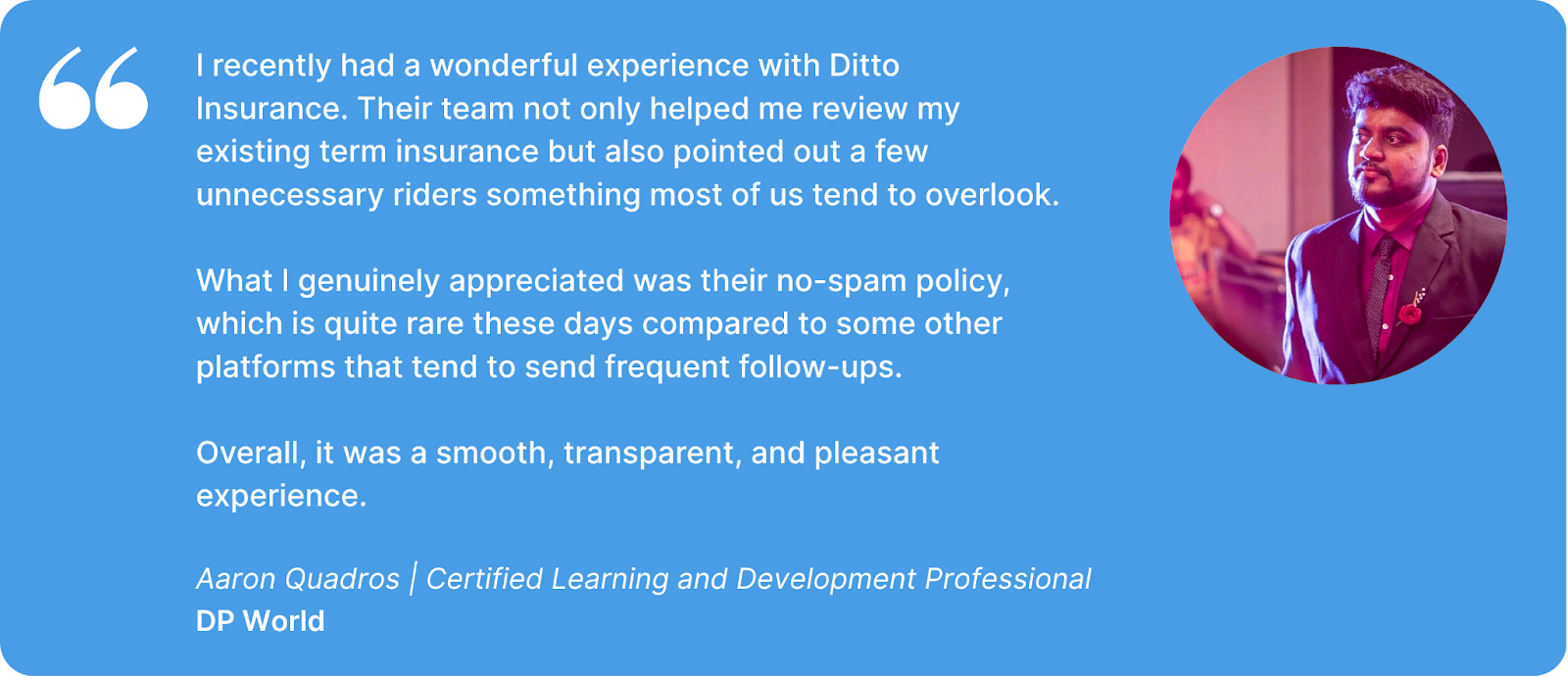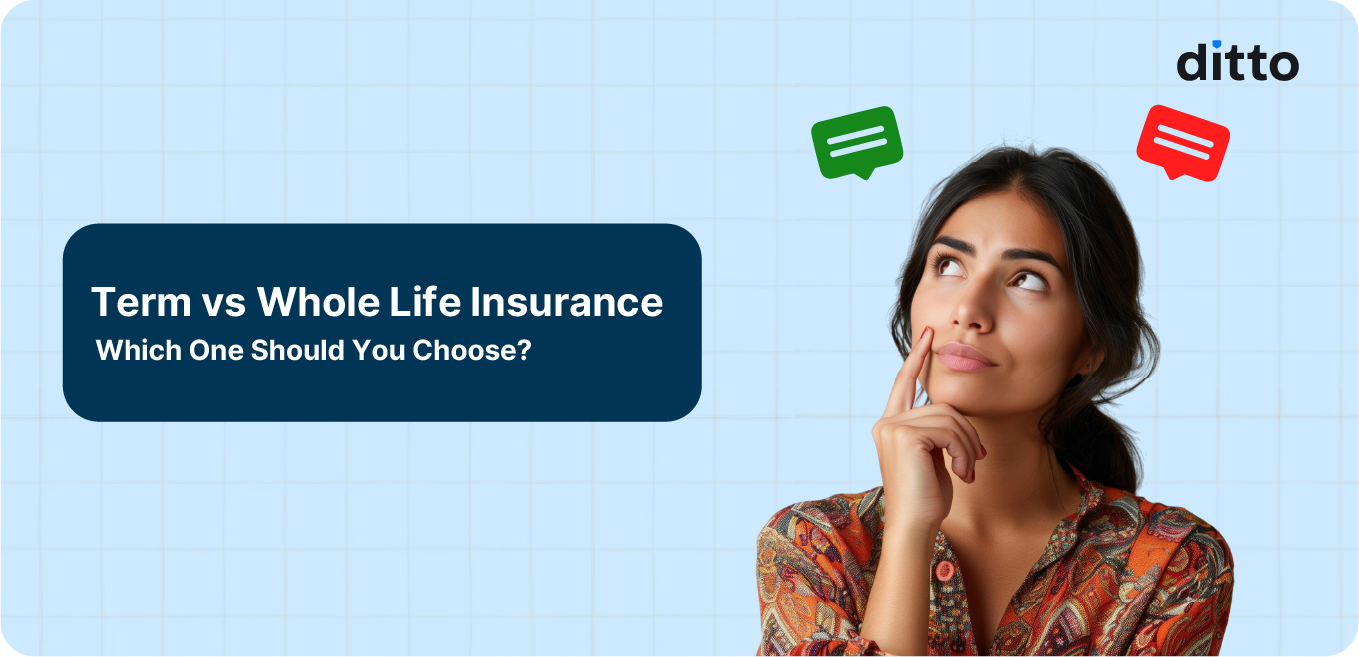Term insurance offers straightforward protection for a set period and pays a benefit only if you pass away during that time.
Whole life insurance, on the other hand, provides coverage for your entire life (usually up to age 99 or more) and includes a cash value component that grows over time. These are more expensive than term plans.
Introduction
“Isn’t a Whole Life plan better since it guarantees a payout?”
That’s one of the most common questions our advisors get at Ditto. Many people assume Whole Life Insurance is superior simply because it promises lifelong coverage and a payout no matter when you die.
But is it better than a Term Plan? In this guide, we break down the difference between Term and Whole Life Insurance alongside their purpose, cost, benefits, and long-term value to help you understand which one truly fits your financial goals.
You can book a free consultation to understand the difference between term and whole life insurance for your needs. Slots are filling fast – WhatsApp or book your call now!
Difference Between Term Life Insurance And Whole Life Insurance
What is Term Life Insurance?
Term life insurance is the simplest and most affordable form of life insurance. It is designed for pure protection for a fixed term or period, such as 10, 20, 30, or 40 years.
- Payout: The death benefit (Sum Assured) is paid out to your family only if you pass away during the specified policy term.
- Survival: If you survive the term, the policy simply expires, and you receive nothing back [unless you chose the Term Return of Premium (TROP) plan]. However, TROP plans are usually 70–100% more expensive and only return your base premium (principal) without adding any interest, profit, or capital gain.
- No Savings Component: Because it has no savings or investment element, the premiums are significantly lower.
Term insurance is ideal for protecting your family during your key earning years when you have financial responsibilities such as loan repayments, young children to support, or other obligations.
Some of our recommended term insurance plans include HDFC Life Click2Protect Supreme, ICICI Prudential iProtect Smart Plus, Max Life Smart Term Plan Plus, Bajaj Allianz e-Touch II, and TATA AIA Sampoorna Raksha Promise.
What is Whole Life Insurance?
Whole life insurance is a type of permanent life insurance that provides guaranteed coverage for your entire life, typically until age 99 or 100. As per IRDAI’s master circular, any policy without a fixed term that continues until death or offers coverage at least up to age 80, is considered a Whole Life plan.
It is defined by two key features:
- Lifelong Protection: The death benefit is guaranteed to be paid to your nominees whenever you pass away (as long as the policy is active).
- Cash Value Accumulation: A portion of your premium is invested by the insurer to build a cash value within the policy. This amount grows over time without yearly taxation and continues to accumulate until you withdraw or surrender the policy. This cash value grows at a guaranteed rate and can be:
- Borrowed against (as a policy loan). This option is typically available after paying premiums for 2–3 years.
- Withdrawn during emergencies.
- Used to surrender the policy for a lump sum (though this cancels the life cover).
Did You Know? Some whole life plans in India (like LIC's Jeevan Umang) are designed to provide a guaranteed annual income (typically 8% of the Sum Assured) that starts after the premium paying term (PPT) is over and continues for life. This feature is only for limited-pay plans; if you pay premiums your whole life, you won’t get this guaranteed payout. Other examples of whole life insurance policies include Tata AIA Sampoorna Raksha Promise, Max Life Smart Secure Plus, HDFC Life Click 2 Protect 3D etc.
Term Insurance vs Whole Life Insurance
While both protect your family, they do so in very different ways:
1) Core Purpose
- Term (Income Replacement & Debt Protection): Designed to provide a large, tax-free payout to replace your income during your key earning years.
- Whole Life (Guaranteed Lifetime Payout & Wealth Transfer): Ensures a payout regardless of when you die and acts as a tool for savings or legacy planning. (Unless you’d rather invest the premium difference in SIPs, PPFs, or other growth instruments that leave your loved ones with more wealth while you’re still alive.)
2) Affordability and Coverage
Term plans offer maximum coverage at the lowest cost and give you better leverage.
For instance: A 25-year-old buying an HDFC Click 2 Protect Supreme plan for ₹2 crore cover till age 60 pays about ₹18,300 per year.
For Edelweiss Life Insurance’s Zindagi Protect Plus, the same sum assured with a cover up to age 99 costs ₹31,507 per year, roughly ₹13,200 more each year or ₹1,100 a month.
Now, if you simply invest that ₹1,100/month in a SIP earning 10% annually, you could build ₹46 lakh by age 60. And if you let the lump sum grow until age 85, it becomes nearly ₹5 crore.
So instead of paying extra for lifelong coverage, you could buy a term plan for pure protection and use the savings to create your own “whole life” corpus, one that you can access and enjoy during your lifetime.
3) Liquidity and Surrender Value
- Term Plans (No Liquidity): They don’t build any cash value. You can’t take loans or withdraw money. If you stop paying, the policy lapses.
- Whole Life Plans (Offer Liquidity): These build a cash value that you can access via loans or withdrawals. However, note that accessing the cash value via a loan or withdrawal often reduces the final death benefit or may incur surrender charges if the policy is cancelled early.
How it Works: Your premium is divided into two parts: one covers the life insurance, while the other builds the policy’s cash value.
Once the cash value reaches a certain level, it forms the basis for the surrender value or a paid-up value. If you choose to surrender the policy early, you will receive the accumulated cash value after deducting any applicable charges or fees.
On the other hand, if you decide to stop paying premiums, your policy continues with a reduced life cover for the remaining term.
In participating plans, the insurer also adds bonuses over time, further increasing the overall policy value.
Cost of Whole Life Insurance vs. Term Life Insurance
When comparing the Difference Between Term and Whole Life Insurance, cost is the most striking factor. Whole life plans can cost significantly more because they guarantee lifelong coverage and include a savings component.
The table below shows how premiums rise sharply when extending the same ₹2 crore cover from age 60 to age 85.
Premium Comparison: ₹2 Crore Cover, Age 25, Salaried Male, Non-smoker
Key takeaway: Extending coverage from age 60 to 85 can raise your yearly premium by 70-150%.
Why Choose Ditto for Term Insurance?
At Ditto, we’ve assisted over 8,00,000 customers with choosing the right insurance policy. Why customers like Aaron below love us:

- No-Spam & No Salesmen
- Rated 4.9/5 on Google Reviews by 15,000+ happy customers
- Backed by Zerodha
- Dedicated Claim Support Team
- 100% Free Consultation
Need clarity before you buy? Book a FREE consultation with our team. Slots are limited, so schedule your call now.
Term vs. Whole Life Insurance: Which One Is Right For You (Ditto’s Take)
The key differences between term and whole life insurance are cost, purpose, and flexibility. Term plans offer high coverage at a much lower cost. Whole Life Insurance makes sense if you’re not confident about managing investments, prefer guaranteed lifelong returns, want to leave a legacy, or have a lifelong dependent.
At Ditto, we believe insurance should first protect your financial obligations. Term plans provide maximum cover with better leverage. If you’re worried about losing money, consider a Zero-Cost Term Plan. It protects you during your working years and lets you get your premiums back when you exit, typically around age 60.
FAQs
Which is better, term or whole life insurance?
Term insurance is generally considered "better" for the average person because it offers significantly higher coverage for a much lower cost. It efficiently covers the period when your family is financially dependent on you. Whole life is only better if your primary goal is legacy planning, guaranteed lifelong savings, or ensuring a payout at any age, which most people do not need.
Can you cash out whole life insurance?
Yes, you can cash out a whole life insurance policy by surrendering it. When you surrender, you receive the accumulated cash surrender value (which is the cash value minus any surrender charges). However, be aware that surrendering the policy immediately cancels all life insurance coverage.
Is whole life insurance a good investment?
Generally, no. While whole life insurance does build cash value, the returns are typically modest and guaranteed, but often lower than what you could achieve by investing the premium difference from a term plan into dedicated investment products like high-quality mutual funds or index funds. Our advisors recommend the "Buy Term and Invest the Difference" strategy.
Does term insurance have a maturity benefit?
No, a standard term insurance plan does not have a maturity benefit. If you survive the policy term, the policy simply ends, and no money is returned. The only exception is a Term with Return of Premium (TROP) plan, which refunds the total premiums paid upon survival, but these plans are much more expensive than a standard term plan.
What are the tax benefits of term life insurance?
Term insurance offers valuable tax benefits under the Income Tax Act: premiums paid are eligible for a deduction of up to ₹1.5 lakh per year under Section 80C (old tax regime), and the death benefit received by your nominees is tax-free under Section 10(10D), subject to prevailing tax laws.
Last updated on:










